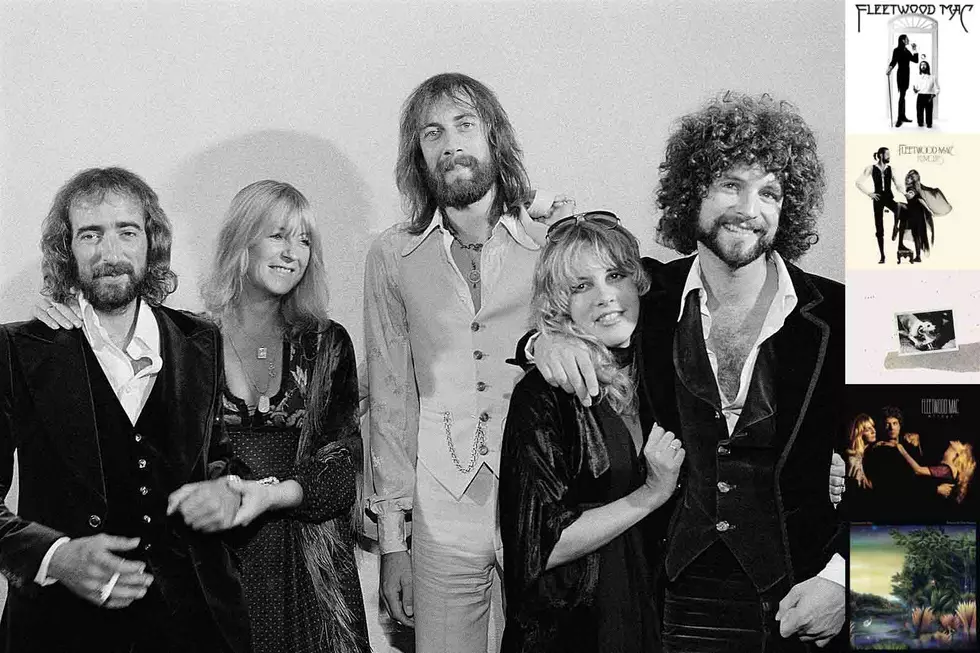
How Fleetwood Mac Made a Masterpiece Out of Messy Relationships on ‘Rumours’
After years simmering beneath the surface of mainstream tastes, Fleetwood Mac finally hit the big time in late 1975. The British blues group, which had been around since 1967 and through various lineup changes since then, recruited a pair of California singer-songwriters for its 10th, self-titled album, and everything almost suddenly changed for them.
Thanks to Lindsey Buckingham and Stevie Nicks, Christine McVie, John McVie and Mick Fleetwood finally scored a No. 1 album, a string of Top 40 hits and a massive tour that helped make them one of the biggest rising bands in the world. And things were about to get a whole lot bigger.
Behind the scenes of all this success, Fleetwood Mac were in a state of disarray – nothing really new for them. But the wrinkles were new this time, as the band's two couples (Buckingham and Nicks, and the McVies) fell apart. Tensions were high as the three chief songwriters (Buckingham, Nicks and Christine McVie) channeled their aggressions, frustrations and hurt into their new songs.
The result was one of the era's all-time greatest albums, and a landmark breakup record: Rumours, which was released on Feb. 4, 1977.
The plan was to keep the momentum going after Fleetwood Mac, which was on its way to becoming a hit just as the band began work on its next record. But the group's personal lives were crumbling around them. The McVies, after six years of marriage, divorced; Fleetwood found out his wife was having an affair around the same time; and Buckingham and Nicks, whose eight-year dating history was marked by fights and periods of cooling off, would barely speak to each other outside of their work.
Listen to Fleetwood Mac's 'Dreams'
Plus, other benefits of the rock 'n' roll lifestyle – like massive amounts of drugs every day and night – were finding their way inside the once low-key group. All of this made the recording of Rumours, which started in February 1976 at California's Record Plant studio with co-producers Ken Caillat and Richard Dashut, a fractured and turbulent process. The plan was to have the album in stores in time for the holidays, but when September rolled around – right around the same time Fleetwood Mac hit No. 1 – and the record still wasn't completed, the schedule was pushed back and a sold-out tour was canceled.
Part of the delay was attributed to Buckingham's increasing control within the studio. Unlike Fleetwood Mac's earlier albums, which were rooted in blues, the 1975 album was a pop record, a direction Buckingham steered Rumours toward even more. He, along with Christine McVie, became the album's architect, as he blended electric and acoustic instruments, pushed for a brighter radio-friendly sound and balanced the voices of the band's three strong songwriters and singers.
Sessions would begin late and last long, if they ever got started at all. Fleetwood had removed all the clocks from the studio, so nobody had their eyes on the time. Not that it really mattered – between all the coke consumed during the recording and various band members not on speaking terms with other members, sometimes not much would get done anyway.
But once they started to finalize the set of songs they had, the band – along with their producers, who were serving as Buckingham's engineers, more or less – began to piece together the parts of their greatest album, overdubbing sections on top of sections. Buckingham contributed "Second Hand News," "Never Going Back Again" and "Go Your Own Way." McVie wrote and sang "Don't Stop" (the inspiration behind the LP's original title, Yesterday's Gone), "Songbird" and "You Make Loving Fun." And Nicks – Fleetwood Mac's breakout star thanks to "Rhiannon" – checked in with "Dreams" (the group's only No. 1 single) and "Gold Dust Woman." And the entire band was given credit on "The Chain," a sorta self-referential look at the state of the band at the time.
Listen to Fleetwood Mac's 'You Make Loving Fun'
They strived for an album with no filler, and they pretty much achieved it. The band's disintegrating relationships were at the center of the record's best songs. Buckingham's "Go Your Own Way," a middle finger to Nicks, is all seething, spiteful fury capped by an angry, tension-filled guitar solo; McVie's "You Make Loving Fun" was written for her new boyfriend, the band's lighting director; and Nicks' "Dreams" was a reality-soaked assessment of the end of her relationship with Buckingham.
Rumours was loaded with emotional highs and lows, as well as the bitter turmoil they had put each other through and had been through together. It was a personal record about very real breakups, but it was also universal in its approach to the subjects. And, probably for those reasons, it was an immediate hit, reaching No. 1 and staying there for 31 weeks. It's still one of the Top 10 bestselling albums ever made.
But the toll on the band was huge. Sinking deeper into a coke addiction, Nicks was distraught that one of her best songs, "Silver Springs," was pulled from the album and relegated to a B-side. Buckingham emerged as the group's leader, which didn't sit particularly well with some members, especially Nicks, whose relationship with her ex-boyfriend was at its lowest point (it probably didn't help matters that she was super-pissed about "Go Your Own Way" and had a rebound fling with Fleetwood to boot). And the band went on tour for what seemed like forever.
By the time they returned in late 1979 with the double-record Tusk, Fleetwood Mac were one of the biggest bands on the planet. Over the next decade, records became less frequent, solo albums took priority and Buckingham left until their 1997 reunion. The messy relationships that inspired their masterpiece were far behind them, but the scars were still there. But what glorious, career-defining scars they were.
Rejected Original Titles of 30 Classic Albums
Rock Feuds: Stevie Nicks vs. Lindsey Buckingham
More From Ultimate Classic Rock









